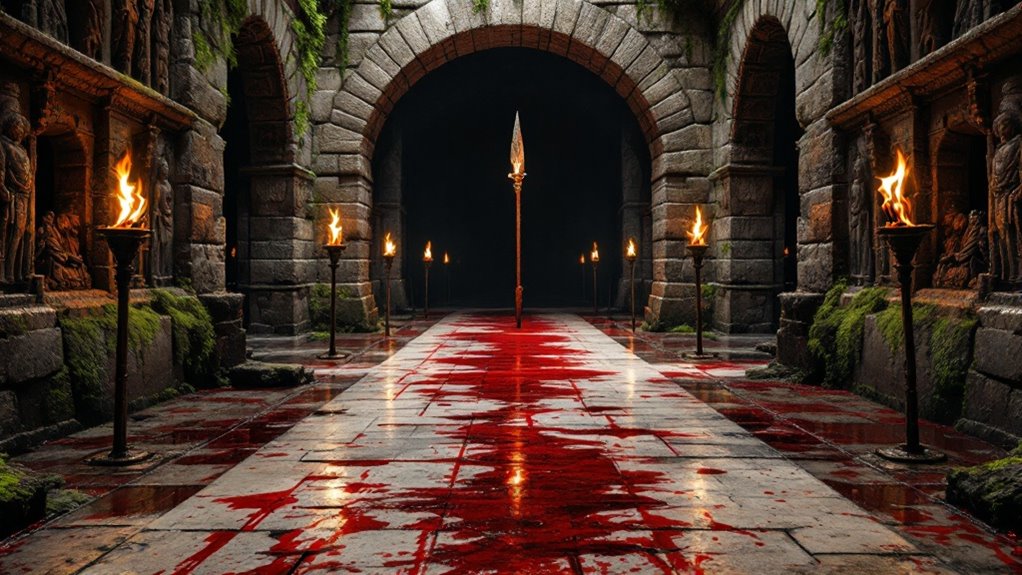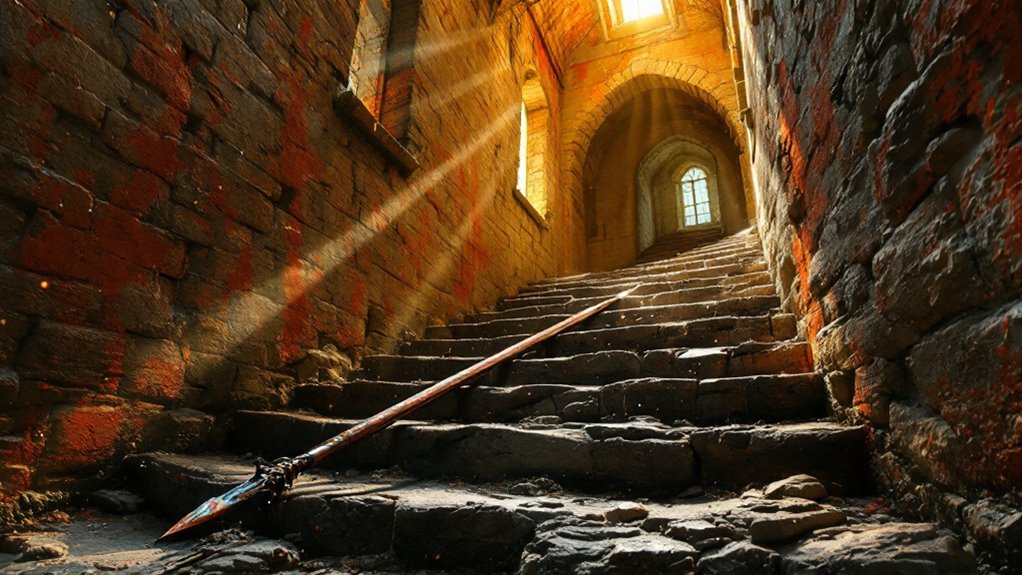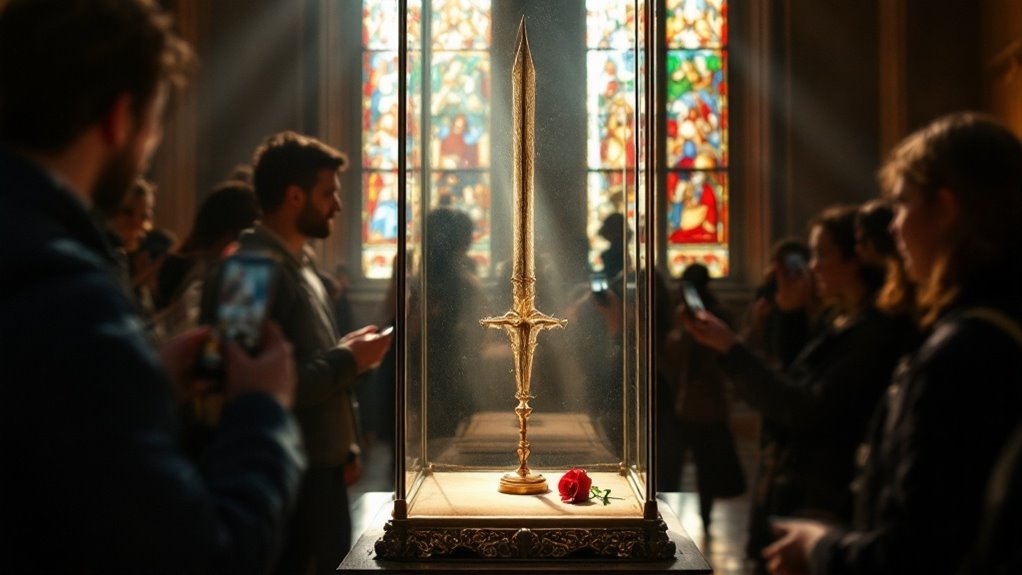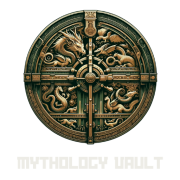I've tracked the sacred lance's journey through thousands of years of myth and martyrdom, where blood and belief intertwine in an eternal dance.
You'll spot its shadow in every culture that honors the power of divine weapons—from Odin's spear Gungnir to the blade that pierced Christ's side. It's a tale that surpasses mere historical artifact, speaking to humanity's deepest longings for a connection with the divine.
As I unravel this story of faith, power, and sacrifice, you'll uncover how a simple Roman weapon transformed into a symbol that keeps captivating hearts and challenging minds across centuries.
Origins of the Sacred Spear

The Holy Lance first showed up in history books thanks to a guy named Antoninus of Piacenza, who was on a pilgrimage back in the 6th century. It's pretty wild how this spear, wielded by a Roman centurion called Longinus, ended up stabbing Jesus in the side during the crucifixion – and that only made it into John's Gospel. The sacred weapon was kept in Jerusalem's Basilica during Antoninus's visit.
But here's the really interesting bit: texts from way back when say that Longinus had some serious eye issues that miraculously cleared up when Jesus' blood hit him. Can you believe it? That moment totally transformed him – he converted on the spot. I've been digging into how this story morphed over time, starting with the Gospel of Nicodemus, which was written way after Jesus kicked the bucket but first gave us the name of that centurion who later became known as Saint Longinus in Christian tradition.
Faith Forged Through Battle
The ancient path of faith runs through the heart of every battle, whether fought with steel or spirit. I've discovered that true strength flows not from our mortal arms but from divine wells deeper than human limitation. When you grasp this truth, you'll find yourself equipped with weapons forged in eternal fires.
Like David before Goliath, I've learned that victory comes not through physical might but through unshakeable trust in a higher power. The Word stands as your iron rod, your shield against darkness. In times of profound disorientation, I've seen how faith becomes the anchor that holds firm. God's armor must be worn complete and intact to ensure victory.
Your battle isn't against flesh and blood – it's fought in domains unseen. Yet through this crucible, your spirit emerges tempered, your faith refined, ready to face whatever shadows may rise.
Legends and Lost Relics

Sacred lances pierce through centuries of myth and memory, each claiming to be the weapon that drew divine blood at Calvary. I've traced these relics' paths through time, watching them splinter and multiply like echoes of power across the ancient world. From Jerusalem's fall to Constantinople's glory, from crusader victories to hidden bunkers, these sacred spears have carved their own destiny. The Imperial Treasury at Hofburg now houses one of history's most scrutinized versions of the lance.
So what's the story behind these legendary weapons?
Take a look at the most compelling chapters in this eternal quest:
- The lance's tip was separated in 615 AD during Chosroes II's conquest, kickstarting its fragmented journey across history.
- Peter Bartholomew's vision in Antioch sparked a crusader victory that altered the course of history in 1098.
- Sultan Bayezid II sent a lance to Rome in 1492, adding another twist to this complex web of competing claims.
Today, these relics rest in Rome, Vienna, and Vagharshapat. Each one whispers its own version of the truth.
Scientific Evidence and Historical Records
It's interesting to dive into the intersection of science and history, shedding light on the truth that lies beyond myths and legends. While the Holy Lance certainly holds enduring spiritual significance, I've found its physical evidence to be quite elusive. Unlike the documented bloodstains on the Shroud of Turin or the scientific analyses of Eucharistic miracles, the Lance story exists primarily in historical records.
| Time Period | Historical Evidence | Scientific Analysis | Cultural Impact |
|---|---|---|---|
| 1st Century | Gospel Account | None Available | Religious Symbol |
| 11th Century | First Crusade | None Available | Military Morale |
| Medieval Era | Imperial Regalia | None Available | Political Power |
| Modern Times | Multiple Relics | None Available | Sacred Mystery |
Still, I can't help but be intrigued by how the Lance's story persists through empirical darkness, its power lying not in laboratory findings but in humanity's enduring quest for divine connection. While science hasn't validated its authenticity, historical documents trace its bloody path through empires and epochs.
Modern Legacy and Cultural Impact

Throughout the ages, artifacts known as Holy Lance relics have continued to wield a profound influence across religious, cultural, and historical spheres. I've witnessed firsthand how these sacred spears transcend their physical forms, becoming powerful symbols that ignite the human spirit in our quest for divine connection and triumph.
Today, you can see the lance's enduring impact manifested in various ways:
- Tourists and pilgrims flock to Vienna, Rome, and Vagharshapat, seeking a connection with these powerful artifacts.
- Documentary films and historical studies delve into the intersection of faith, warfare, and human determination.
- Theological debates continue to rage about authenticity and the role of relics in modern spiritual practice.
The Holy Lance's legacy endures as a testament to humanity's eternal search for divine approval and the mythological power we invest in sacred objects.
Frequently Asked Questions
Why Did Soldiers Not Preserve the Holy Lance Immediately After the Crucifixion?
"Yeah, I get it. The soldiers at that time weren't interested in keeping relics around, not realizing it'd become a big deal in later Christian stories."
How Many People Died Trying to Prove the Lance's Authenticity?
There's only one recorded death – Peter Bartholomew. In 1098, the guy walked through fire to prove the lance was the real deal but ended up burning to a crisp. What a way to go, huh?
What Materials Were Historically Used to Create Replicas of the Lance?
Ancient craftsmen used sacred materials to create replicas of the lance: iron formed the core, while later iterations featured silver and gold sleeves. In contrast, modern replicas use carbon steel and brass to capture its essence.
Did Any Popes Officially Denounce Specific Claims About the Holy Lance?
Despite the numerous relics scattered across medieval Europe, no pope officially spoke out against any particular claims about the Holy Lance. They kept quiet on the matter, possibly because of the politically sensitive nature of the lance throughout history.
Were There Documented Attempts to Steal the Lance From Its Various Owners?
Yes, many tried to steal the holy lance throughout history. From when Persians conquered it to when Constantinople got sacked, a lot of people wanted to get their hands on it for its supposed power.

